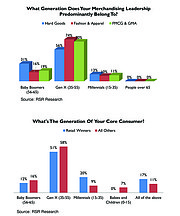RETAIL
The Future in Retail Leadership Lies in Discovering Its Core Customer and Technology
For retailers, it should be more about millennials.
This generation—between the ages of 15 and 35—is just entering its prime shopping years as millennials start families and ramp up purchases of homes, which need to be filled with furniture, home accessories and clothes to fill their closets.
But retailers are not integrating those millennials into their army of merchandising leaders to figure out what millennials want to buy.
In fashion and apparel, only 10 percent of retailers’ merchandising leadership are millennials while 74 percent of those merchandisers belong to the Gen X generation, between the ages of 35 and 55, according to a report by Retail Systems Research, a Miami company that collects data on the retail industry and focuses on the impact of technology on retail.
Winning retailers have more millennial customers (20 percent) than less successful concerns (9 percent), the report said. Successful retailers count 51 percent of their customers as Gen Xers while less profitable ventures said 58 percent of their consumers were from that age group.
“Like any generation gone before them, millennials want people speaking their language and offering them products they want to buy,” said Steve Rowen, a managing partner at RSR. “This sort of dismissive idea that millennials are into sharing and the gig economy and won’t buy anything is not true. These kids are not teenagers anymore. They are settling down, have homes and are filling them with stuff. It is a tremendous missed opportunity.”
Rowen recommends getting millennials into some kind of leadership program or retail career path to help stores make the transition to catering to those consumers.
Another drawback for retailers is their sourcing programs. “We have long believed that sourcing product from half a world away from the point of demand has three impacts: It’s a slow way to get product to market, it forces buyers to place ‘big bets’ to get the best price from far-flung factories, and since they are placing big bets those bets tend to be conservative,” the report said. “It takes so long for product to arrive that once it does, if it proves to be a poor seller, the only choice is an immediate and painful markdown.”
Retailers still haven’t come to grips with the idea of being speedier and more agile in making product decisions, and it is unlikely that most retailers will source in the United States any time soon.
Some 55 percent of those retailers surveyed did not believe that the reliance of imports makes them too conservative. But conservative and boring products, which often are a result of long-range planning, make retailers more dependent on lower price to sell their goods.
That leads to price wars—a never-ending battle that is starting to lose a bit of its luster. Close to half the retailers surveyed by RSR said they believe the race to the bottom is over because businesses are charging so little for their products that it is difficult to go lower.
A recent comparison between Walmart and Amazon.com showed Walmart’s in-store prices were 10.4 percent lower than those of the e-commerce powerhouse.
One of retailers’ biggest concerns is the fact that everyone is selling the same or similar products. Sixty-five percent of retailers said they face this difficulty, which launches a series of price wars, while 60 percent of retailers fear that shoppers are still sensitive to higher prices.
To get beyond this, retailers need to match demand with product supply to improve their margins. They also need to start providing better customer service, holding fewer doorbusters and stocking innovative products that are different.
Some 55 percent of fashion and apparel retailers said their in-store merchandise is broad to cover multiple lifestyles and ages while 48 percent of their online merchandise fell into that same category. But everyone is trying to tweak the model to see what works best for them.
Increasingly, technology is being employed to provide a solution for some of these merchandise problems. Recently teen retailer Rue21 said it would be using predictive analytics to better determine merchandise sell-through. It selected First Insight’s predictive analytic tools to help designers and buyers decide which products to source for apparel, footwear and accessories. The struggling retailer will test a new range of products to determine what will best drive speed to market and help eliminate underperforming merchandise.
This is all a part of retailers moving away from selecting merchandise based on gut feelings instead of getting more accurate with technology. Winning retailers are more prone to adapt technology into their systems than struggling retailers, the report said, but fashion retailers are less likely to embrace the tech world.
“Many [fashion retailers] did not believe that technology could keep up with what they do,” Rowen said. “People selling table saws are more apt to adapt technology and keep up with consumer demand than fashion retailers.”
On another technology level, RSR analysts believe that retailers need to narrow their visible assortments seen online. Through technology, a broad assortment can be made to appear narrower, based on personalized home pages.
Retailers also have to get better at predicting which products will fly out the door and which ones will be stuck on the shelves. They have to do pre-forecasting and then update that with more forecasting.
However, at the end of the day, retail is retail. The best solutions still remain plan, buy, sell, analyze and then start all over again.






















